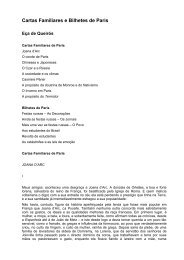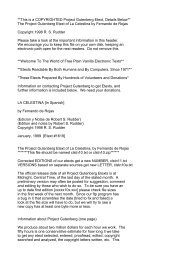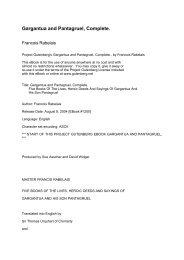The Interpretation of Dreams Sigmund Freud (1900)
The Interpretation of Dreams Sigmund Freud (1900)
The Interpretation of Dreams Sigmund Freud (1900)
You also want an ePaper? Increase the reach of your titles
YUMPU automatically turns print PDFs into web optimized ePapers that Google loves.
new and further detours. But the number and form <strong>of</strong> the collaterals which we thus contrive during the day are, psychologically speaking,<br />
indifferent, so long as they point the way to the dream-thoughts which we are seeking.<br />
B. Regression<br />
Now that we have defended ourselves against the objections raised, or have at least indicated our weapons <strong>of</strong> defence, we must no longer delay<br />
entering upon the psychological investigations for which we have so long been preparing. Let us summarize the main results <strong>of</strong> our recent<br />
investigations: <strong>The</strong> dream is a psychic act full <strong>of</strong> import; its motive power is invariably a wish craving fulfilment; the fact that it is unrecognizable<br />
as a wish, and its many peculiarities and absurdities, are due to the influence <strong>of</strong> the psychic censorship to which it has been subjected during its<br />
formation. Besides the necessity <strong>of</strong> evading the censorship, the following factors have played a part in its formation: first, a need for condensing<br />
the psychic material; second, regard for representability in sensory images; and third (though not constantly), regard for a rational and intelligible<br />
exterior <strong>of</strong> the dream-structure. From each <strong>of</strong> these propositions a path leads onward to psychological postulates and assumptions. Thus, the<br />
reciprocal relation <strong>of</strong> the wish-motives, and the four conditions. as well as the mutual relations <strong>of</strong> these conditions, must now be investigated; the<br />
dream must be inserted in the context <strong>of</strong> the psychic life.<br />
At the beginning <strong>of</strong> this section we cited a certain dream in order that it might remind us <strong>of</strong> the problems that are still unsolved. <strong>The</strong> interpretation<br />
<strong>of</strong> this dream (<strong>of</strong> the burning child) presented no difficulties, although in the analytical sense it was not given in full. We asked ourselves why,<br />
after all, it was necessary that the father should dream instead <strong>of</strong> waking, and we recognized the wish to represent the child as living as a motive<br />
<strong>of</strong> the dream. That there was yet another wish operative in the dream we shall be able to show after further discussion. For the present, however,<br />
we may say that for the sake <strong>of</strong> the wish-fulfilment the thought-process <strong>of</strong> sleep was transformed into a dream.<br />
If the wish-fulfilment is cancelled out, only one characteristic remains which distinguishes the two kinds <strong>of</strong> psychic events. <strong>The</strong> dream-thought<br />
would have been: "I see a glimmer coming from the room in which the body is lying. Perhaps a candle has fallen over, and the child is burning!"<br />
<strong>The</strong> dream reproduces the result <strong>of</strong> this reflection unchanged, but represents it in a situation which exists in the present and is perceptible by the<br />
senses like an experience <strong>of</strong> the waking state. This, however, is the most common and the most striking psychological characteristic <strong>of</strong> the dream;<br />
a thought, usually the one wished for, is objectified in the dream, and represented as a scene, or - as we think - experienced.<br />
But how are we now to explain this characteristic peculiarity <strong>of</strong> the dream-work, or - to put it more modestly - how are we to bring it into relation<br />
with the psychic processes?<br />
On closer examination, it is plainly evident that the manifest form <strong>of</strong> the dream is marked by two characteristics which are almost independent <strong>of</strong><br />
each other. One is its representation as a present situation with the omission <strong>of</strong> perhaps; the other is the translation <strong>of</strong> the thought into visual<br />
images and speech.<br />
<strong>The</strong> transformation to which the dream-thoughts are subjected because the expectation is put into the present tense is, perhaps, in this particular<br />
dream not so very striking. This is probably due to the special and really subsidiary role <strong>of</strong> the wish-fulfilment in this dream. Let us take another<br />
dream, in which the dream-wish does not break away from the continuation <strong>of</strong> the waking thoughts in sleep; for example, the dream <strong>of</strong> Irma's<br />
injection. Here the dream-thought achieving representation is in the conditional: "If only Otto could be blamed for Irma's illness!" <strong>The</strong> dream<br />
suppresses the conditional, and replaces it by a simple present tense: "Yes, Otto is to blame for Irma's illness." This, then, is the first <strong>of</strong> the<br />
transformations which even the undistorted dream imposes on the dream-thoughts. But we will not linger over this first peculiarity <strong>of</strong> the dream.<br />
We dispose <strong>of</strong> it by a reference to the conscious phantasy, the day-dream, which behaves in a similar fashion with its conceptual content. When<br />
Daudet's M. Joyeuse wanders unemployed through the streets <strong>of</strong> Paris while his daughter is led to believe that he has a post and is sitting in his<br />
<strong>of</strong>fice, he dreams, in the present tense, <strong>of</strong> circumstances that might help him to obtain a recommendation and employment. <strong>The</strong> dream, then,<br />
employs the present tense in the same manner and with the same right as the day-dream. <strong>The</strong> present is the tense in which the wish is represented<br />
as fulfilled.<br />
<strong>The</strong> second quality peculiar to the dream alone, as distinguished from the day-dream, is that the conceptual content is not thought, but is<br />
transformed into visual images, to which we give credence, and which we believe that we experience. Let us add. however, that not all dreams<br />
show this transformation <strong>of</strong> ideas into visual images. <strong>The</strong>re are dreams which consist solely <strong>of</strong> thoughts, but we cannot on that account deny that<br />
they are substantially dreams. My dream Autodidasker - the day-phantasy about Pr<strong>of</strong>essor N is <strong>of</strong> this character; it is almost as free <strong>of</strong> visual<br />
elements as though I had thought its content during the day. Moreover, every long dream contains elements which have not undergone this<br />
transformation into the visual, and which are simply thought or known as we are wont to think or know in our waking state. And we must here<br />
reflect that this transformation <strong>of</strong> ideas into visual images does not occur in dreams alone, but also in hallucinations and visions, which may<br />
appear spontaneously in health, or as symptoms in the psychoneuroses. In brief, the relation which we are here investigating is by no means an<br />
exclusive one; the fact remains, however, that this characteristic <strong>of</strong> the dream, whenever it occurs, seems to be its most noteworthy characteristic,<br />
so that we cannot think <strong>of</strong> the dream-life without it. To understand it, however, requires a very exhaustive discussion.<br />
Among all the observations relating to the theory <strong>of</strong> dreams to be found in the literature <strong>of</strong> the subject, I should like to lay stress upon one as<br />
being particularly worthy <strong>of</strong> mention. <strong>The</strong> famous G. T. H. Fechner makes the conjecture,[15] in a discussion as to the nature <strong>of</strong> the dreams, that









